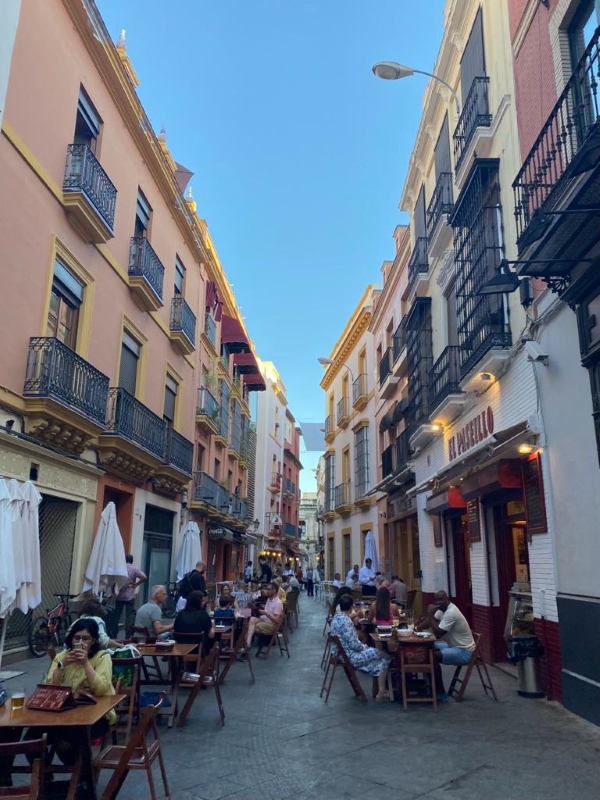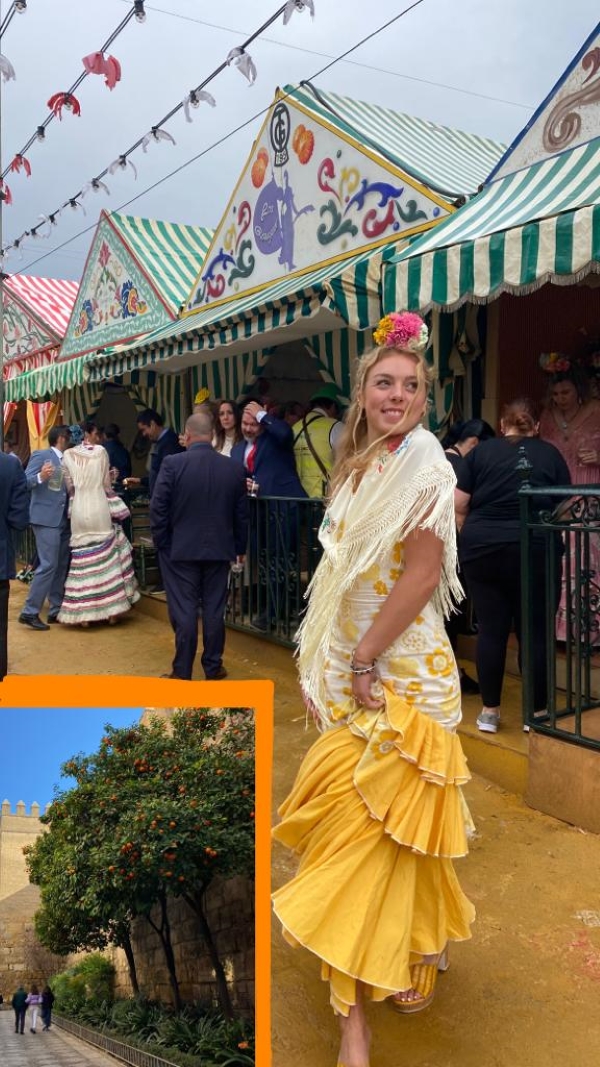Seville vs. Madrid: A Quiz to Find your Study Abroad Match
Compatibility Quiz:
1. I prefer to spend my free time...
A. Discovering cool, trendy, artistic, or stylish shops
B. Wandering through winding cobblestone streets
2. When it comes to eating, I’m a fan of…
A. Having a lot of variety in cuisine types
B. Embracing typical dishes and tasting traditional things
3. I’d say my ideal approach to life is more…
A. Busy and active
B. Day-by-day and relaxed
4. When I think about my weekends abroad, I picture…
A. Frequently jetting off to a new country to explore more of Europe
B. Staying in the country to experience the culture deeper
5. What’s important to me about my host city is…
A. Diversity, so I can meet many new types of people
B. Beautiful architecture and a European feel
6. To get around the city, I’d be happier to rely on…
A. Public transportation
B. My own two feet
7. When studying abroad, I’d love to visit…
A. France, Italy, Switzerland
B. Gibraltar, Morocco, Mallorca
Have you decided to study abroad in Spain but don’t know which host location to choose? I have some unique insight to share with you concerning life in two distinct Spanish cities: Madrid and Seville. Why am I qualified to inform you about this significant decision, you might ask? Well, on a journey of self-discovery and Spanish speaking skills, I pursued two separate study abroad semesters in these locations. Both of my experiences have been incredible, and each spot has plenty of alluring features that lend themselves to an amazing study abroad adventure. But the questions you just answered bring up some interesting points, so let me tell you more…

Intricate entrances like the one of the building pictured are certainly present in Madrid, though they are hidden among the newer structures built to serve as apartments and commercial spaces. Exploring this city is like a treasure hunt!
Question 2: Convenience and Cuisine
In the United States, we live in a bubble of convenience. It’s easy to obtain a hot meal at any time of day or receive an online order to your doorstep within just 24 hours. Cosmopolitan Madrid has adopted some of these practices, making the lives of its citizens (and visitors) a little bit easier. Though not nearly as prolific as in the U.S., you can find fast food restaurants or convenience stores open 24 hours in this capital city. The same can’t be said about Seville, where a more traditional approach to business operating hours is taken. Seville functions with the mindset of prioritizing the well-being of ALL its citizens, including workers of any level, by closing during siesta hours (between 2-4pm), throughout the night, and on Sundays. If you can’t imagine a life without midnight snacks or quick deliveries, Madrid may be more to your liking.
Another element related to convenience that is brought about by the infrastructure, demand and population influx in Madrid is the variety of cuisine types available. While tapas are a traditional type of food in both cities, I consumed significantly more Spanish omelet, baked goat cheese, and patatas bravas (examples of tasty tapas) in Seville. There are thousands of restaurants lining the streets of Madrid, and plenty of them serve typical Spanish dishes, but it’s difficult to resist the allure (and habit) of the establishments serving Mexican or Asian food that are a result of the rampant globalization occurring in this city. Seville also has spots for a hiatus from Spanish cuisine with tacos or sushi, just fewer. Undoubtedly, the melting pot that is Madrid, benefits and all, causes a dilution of Spanish culture. If you’re looking for strong immersion without having to try too hard to seek it out, Seville awaits. The food in Madrid is delicious and of countless different types. Gastronomical markets dotted around the city, such as the Mercado de Antón Martín, hold some of the best eateries, such as an Asian restaurant serving these masterpieces composed of noodles and rice.

The food in Madrid is delicious and of countless different types. Gastronomical markets dotted around the city, such as the Mercado de Antón Martín, hold some of the best eateries, such as an Asian restaurant serving these masterpieces composed of noodles and rice.
Question 1 and 3: Approach to Life
As a huge urban city of more than 3 million inhabitants, Madrid moves fast. Tires screeching, people hustling, sirens blaring—classic traits of a big city. The size and prominence of this metropolis has fostered a unique lifestyle characterized by a fast pace compared to what one may consider the “traditional” Spanish approach, typically marked by unhurriedness. This style compounds itself, attracting Spain’s largest businesses, the most motivated, busy-bee workers, and students looking to live out their big-city dreams. Madrid is the Spanish land of options, events, progress, and future.
On the other hand, Seville is the poster child for the laid-back Spanish approach to life. Let’s just say I was taking significantly more naps during my time in Southern Spain than here in Madrid…in this regard, I’d say Madrid’s manner is more like the U.S. than I expected after my time in Seville. Due to the fact that I have a marketing internship position here in the capital, it does feel fitting to be in the big city environment and may be better preparing me for the reality of a career back in the States.

A relaxed day can be spent in Seville’s historic center, a labyrinth of blocks which hold many of the city’s most popular shops and restaurants. This area is characterized by pedestrian streets, skinny alleyways, and historic buildings.
Question 4 and 7: Location and Weather
Madrid being a large capital city means that its airport is massive—a true European hub (flying to 179 destinations). If you picture yourself frequently taking advantage of affordable flights on the weekends, studying in Madrid would make your life a little easier. However, I do not recommend planning getaways during every spare moment you have, since studying abroad is a special opportunity to get to know the place you’re living in more deeply: its culture, contributions, and secrets. Seville’s airport and relative connections are nothing to scoff at, however, with flights to Italy, Morocco, the UK, and many more (73 destinations). Due to its Southern location, you’d have the chance to discover interesting nearby places like Gibraltar or the Algarve Coast of Portugal.
Seville’s southern whereabouts also dictate weather patterns that are quite distinct from Madrid. It’s considerably sunnier and hotter, which can be a blessing or a curse. Though I recommend avoiding the area in the summer months when the heat becomes unbearable and even the locals flee to the coast or to summer homes in the countryside (with pools), the other months of the year are quite pleasant. I studied in Seville in the spring (February to the end of May). It was chilly at first, but not freezing, I got to enjoy the blooming of the orange trees which filled the city with a marvelous scent and had plenty of time for beach trips toward the end of my stay. Another plus about spending this semester in Seville is that I got to experience the Feria de Abril, an unforgettable local festival of food, friends, and flamenco. Madrid is cooler year-round, especially in the fall and winter, though still very agreeable (and apt for the ubiquitous Spanish fashion trend of scarf-wearing). My arrival in September was greeted by a string of warm, sunny days, but I’ve since enjoyed watching the city transform into a festive fall setting with orange leaves swirling in the air as the seasons progress.
One more thing to mention about Seville’s southern position is the effect on the accent of these local Andalusian (corresponding region of Spain) Spanish speakers. It is known to be more difficult for outsiders to understand, as they speak very rapidly, connecting words and dropping letters. So, if you’re up for a challenge…! Learning Spanish while studying in Spain is a given, in my opinion, and both locales will provide plenty of great opportunities to practice and pick it up. What’s more, as a Spanish minor, I was pleasantly surprised that English isn’t spoken as much as I expected in Madrid, considering its ubiquity in other parts of Europe.

A spring in Seville was marked by trees heavy with oranges and a week off of school to celebrate the Feria de Abril (April Fair). My roommates and I thrifted second-hand dresses, acquired all of the accessories, and fully embraced the experience.
Question 5 and 6: City Look and Layout
The streets of Seville generate a very distinct European feel, very different from what our unadorned buildings in the States evoke. The architecture, specifically in the city center where you would frequently be passing through, is remarkable. The fact that the majority of the streets in the centro are reserved for pedestrians is especially conducive to observing these beautiful buildings. The separation from speeding vehicles further adds to the perceived slower pace of life mentioned earlier. Madrid also has its fair share of beautiful structures which are similarly centralized in the historic center of the city. However, expansions made to accommodate growth means you won’t always be crossing through this area, and the jewels are less prominent among the modern infrastructure.
To travel across the urban sprawl, Madrid has an extremely extensive metro system, with 13 lines moving underground and intercity light rails as well. It’s an impressive operation that is clean, timely, modern, and heavily utilized by Madrileños. Seville, on the other hand, has one metro line. I did take the metro to my classes at Universidad Pablo de Olavide in Seville but other than that, I went almost everywhere on foot. I never minded the walk since it was always so beautiful as I weaved through small alleyways on my way to the CEA CAPA study center or crossed the bridge over the river, to get to my apartment on the other side. This river, the Guadalquivir, gave me plenty of memories hanging out with friends along its shore and even allowing for a kayaking excursion.

The Guadalquivir River splits Seville into two parts and provides an incredible backdrop. Athletic rowers can be seen exercising on the water at all times of the year, and my roommate and I even tried our hand!
Madrid Vs. Seville: Quiz Results
If you answered:
Mostly A’s: Madrid is the place for you!
Mostly B’s: Seville is calling your name!
In all actuality, you can’t go wrong with either city. They both have unique attributes that will contribute to a truly unforgettable experience. Overall, Spain and its people are incredibly hospitable, and the culture is unlike any other. There is so much to discover, España awaits. ¡Buena suerte!
This post was written by Lily Gould, a Spring 24' Content Creator from Chapman University who studied abroad in both Madrid and Seville, Spain.










